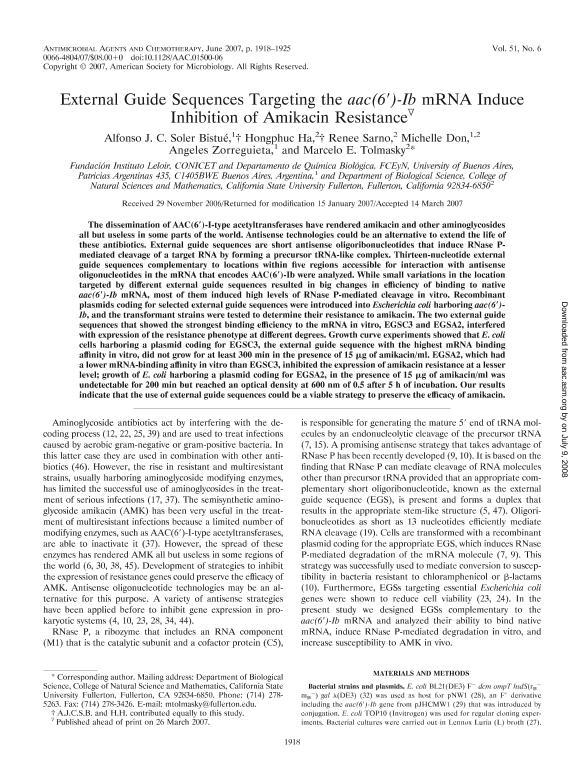Artículo
External guide sequences targeting the aac(6')-Ib mRNA induce inhibition of amikacin resistance
Soler Bistue, Alfonso J. C. ; Ha, Hongphuc; Sarno, Renee; Don, Michelle; Zorreguieta, Ángeles
; Ha, Hongphuc; Sarno, Renee; Don, Michelle; Zorreguieta, Ángeles ; Tolmasky, Marcelo E.
; Tolmasky, Marcelo E.
 ; Ha, Hongphuc; Sarno, Renee; Don, Michelle; Zorreguieta, Ángeles
; Ha, Hongphuc; Sarno, Renee; Don, Michelle; Zorreguieta, Ángeles ; Tolmasky, Marcelo E.
; Tolmasky, Marcelo E.
Fecha de publicación:
03/2007
Editorial:
American Society for Microbiology
Revista:
Antimicrobial Agents and Chemotherapy
ISSN:
0066-4804
e-ISSN:
1098-6596
Idioma:
Inglés
Tipo de recurso:
Artículo publicado
Clasificación temática:
Resumen
The dissemination of AAC(6')-I-type acetyltransferases have rendered amikacin and other aminoglycosides all but useless in some parts of the world. Antisense technologies could be an alternative to extend the life of these antibiotics. External guide sequences are short antisense oligoribonucleotides that induce RNase P-mediated cleavage of a target RNA by forming a precursor tRNA-like complex. Thirteen-nucleotide external guide sequences complementary to locations within five regions accessible for interaction with antisense oligonucleotides in the mRNA that encodes AAC(6')-Ib were analyzed. While small variations in the location targeted by different external guide sequences resulted in big changes in efficiency of binding to native aac(6')-Ib mRNA, most of them induced high levels of RNase P-mediated cleavage in vitro. Recombinant plasmids coding for selected external guide sequences were introduced into Escherichia coli harboring aac(6')-Ib, and the transformant strains were tested to determine their resistance to amikacin. The two external guide sequences that showed the strongest binding efficiency to the mRNA in vitro, EGSC3 and EGSA2, interfered with expression of the resistance phenotype at different degrees. Growth curve experiments showed that E. coli cells harboring a plasmid coding for EGSC3, the external guide sequence with the highest mRNA binding affinity in vitro, did not grow for at least 300 min in the presence of 15 mug of amikacin/ml. EGSA2, which had a lower mRNA-binding affinity in vitro than EGSC3, inhibited the expression of amikacin resistance at a lesser level; growth of E. coli harboring a plasmid coding for EGSA2, in the presence of 15 mug of amikacin/ml was undetectable for 200 min but reached an optical density at 600 nm of 0.5 after 5 h of incubation. Our results indicate that the use of external guide sequences could be a viable strategy to preserve the efficacy of amikacin
Archivos asociados
Licencia
Identificadores
Colecciones
Articulos(IIBBA)
Articulos de INST.DE INVEST.BIOQUIMICAS DE BS.AS(I)
Articulos de INST.DE INVEST.BIOQUIMICAS DE BS.AS(I)
Citación
Soler Bistue, Alfonso J. C.; Ha, Hongphuc; Sarno, Renee; Don, Michelle; Zorreguieta, Ángeles; et al.; External guide sequences targeting the aac(6')-Ib mRNA induce inhibition of amikacin resistance; American Society for Microbiology; Antimicrobial Agents and Chemotherapy; 51; 6; 3-2007; 1918-1925
Compartir
Altmétricas



